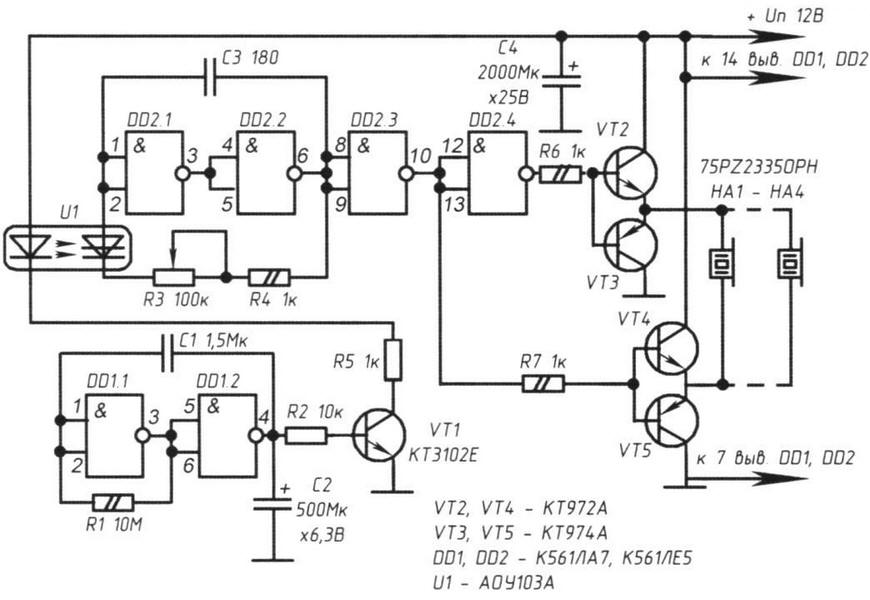Protection for your home and garden from small rodents pests, insects are still relevant today. Various industrial devices "screechers" there is a sale, however, the same device is able to make with ham intermediate level of training. Unlike many schemes such devices, offered below are quite original. Known schemes are based on the generator ultrasonic frequency (UTC), "loaded" on the piezoelectric capsule. The frequency of these generators can be adjusted (adjusted with the changes of the values of RC circuit), but it is immutable in operation, and hence the generator. That is, at any rodents, insects, birds or animals would not have been "programmed" generator OSC (all of these creatures afraid discomfort from pulses of a certain frequency), with time device ceases to be effective due to occur in rodents or insects effect addiction.
In development, discussed below, this disadvantage is absent because in the time of active operation of the device, the oscillator frequency varies over a wide limits. Due to this, the proposed device can be applied universally for many living beings whose presence is undesirable on sites, and those over in the house.
Ultrasonic vibrations with a frequency of 100 kHz are depressing on rats, mice and other small rodents, and the fluctuations 22 - 40 kHz't stand dogs and cats.
Consider wiring diagram harassment devices.
The device effectively in the area up to 10 m2. If you need to increase the area effects, then you must include a piezoelectric capsule through a powerful amplifier that can be implemented by a transistor circuit.

On the elements DD1.1 and DD1.2 the assembled oscillator subsonic frequencies (INCH), "loaded" on the VT1 transistor. This transistor acts as a current amplifier and at the same time the electronic key, the Manager of the optocoupler U1. As optocouplers used thyristor optocoupler, performing the role of a managed key.
The shape of the pulses at the output of this generator is rectangular, so the transistor VT1 depending on the pulse front slowly opened and periodically closes (with a frequency generator INCH). Optocoupler U1 included in the collector the circuit of the transistor VT1, smoothly changes the time constant of the second oscillator, implemented on the elements DD2.1 and DD2.2. Therefore, the frequency range of the second generator varies within wide limits: 20 to 80 kHz.
The elements DD2.3 and DD2.4 connected in the circuit of inverters to ensure that you "rocking" the amplifier transistors VТ2 - VТ5. At the output of the amplifier included several similar piezoelectric elements HA1-ON4. Their total number unlimited and in this scheme to achieve 6-8. The more piezo - the greater area are protected from the invasion of rodents and the like. When connecting output devices 4 piezo transistors VT2 - VT4 you want to install on different heat sinks (since the data collectors transistors combined with their body).
As HA1 need to apply the piezoelectric elements with a resonant frequency of 20 80 kHz. At resonance one element consumes about 30 - 50 mA, so the power source for the design must be of suitable capacity, stable output voltage in the range of 10 to 15 V.
In establishing the device and does not need the good parts starts to work immediately.
Variable resistor R3 sets the range within which the device will change the oscillation frequency of the oscillator.
To see if your device is easy. Since the ear of the person (including individual characteristics) fixes the lower boundary frequency of the generator in USC district 16 - 20 kHz, properly operating the device will periodically "heard" by the human ear for a few moments. It will be quiet a sound similar to a whistle. Then the sound jumps back to higher frequency fluctuations negatively affecting pests.
Details
Transistor VT1 - low-power silicon. Is specified in the diagram apply CT, CT, KT315, 2N5551, US with any letter index. OPTRON U1 can be replaced by AOS with indices B, or equivalent.
Piezoelectric capsule - type NSA, NSMK, SLN and similar designed for a resonant frequency of 20 to 80 kHz.
Oxide capacitors - type K50-29. Non-polar capacitor C1 is type CMB, K10-17 or trivial. It also can be (appropriately) from two oxide capacitors 2 µf, incorporating them consistently positive (or negative) plates to each other.
All fixed resistors - type MLT-0,25. Variable resistor R3-type SPO-1, SDR-1VB or similar.
Author: E. P.






